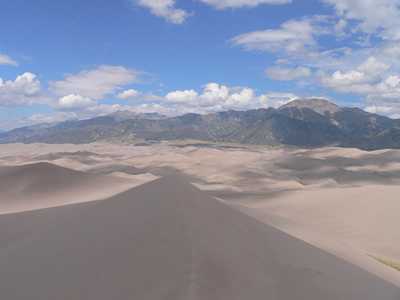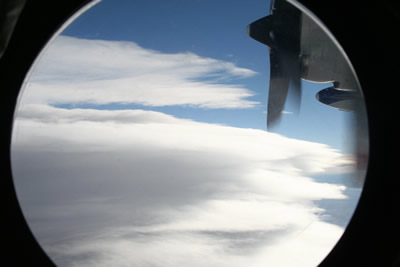Biological particles--bacteria, pollen, fungi--act as nuclei for formation of ice in clouds
Click on image for full size
Image Courtesy of the National Center for Atmospheric Research
Scientists Make First Direct Observations of Biological Particles in High-Altitude Clouds
News story originally written on May 17, 2009
For a long time, scientists have known that microorganisms can get into the atmosphere and travel long distances. But a new study shows how they help influence cloud formation. The effects of these tiny airborne particles called aerosols on how clouds form has been very difficult for scientists to understand. This information can also help scientists understand how clouds affect the climate.
During the project, called Ice in Clouds Experiment - Layer Clouds (ICE-L), scientists studied water droplets and ice crystals at high speeds while flying through clouds in the sky. Scientists learned that the particles that started the growth crystals were made up of dust or biological material such as bacteria and plant material.
Scientists want to learn more about aerosols and clouds because this information will help them predict the future of climate change.
You might also be interested in:

A cloud is composed of tiny water droplets or ice crystals. A series of things have to happen in order for these water droplets or ice crystals to form into clouds in the atmosphere, and different types
...more
When you look up at the sky, you are looking at more than just air. There are also billions of tiny bits of solid and liquid floating in the air. These tiny particles are called aerosols or particulates.
...more
To figure out what the Earth might be like in the future, scientists need to know how Earth reacts to changes. Models help scientists to better understand how the Earth works and how it will react to climate
...more
Scientists have learned that Mount Hood, Oregon's tallest mountain, has erupted in the past due to the mixing of two different types of magma. Adam Kent, a geologist at Oregon State University, says this
...more
The Earth's mantle is a rocky, solid shell that is between the Earth's crust and the outer core. The mantle is made up of many different reservoirs that have different chemical compositions. Scientists
...more
Some faults look strong and like they wouldn’t cause an earthquake. But it turns out that they can slip and slide like weak faults causing earthquakes. Scientists have been looking at one of these faults
...more
The sun goes through cycles that last approximately 11 years. These solar cycle include phases with more magnetic activity, sunspots, and solar flares. They also include phases with less activity. The
...more















